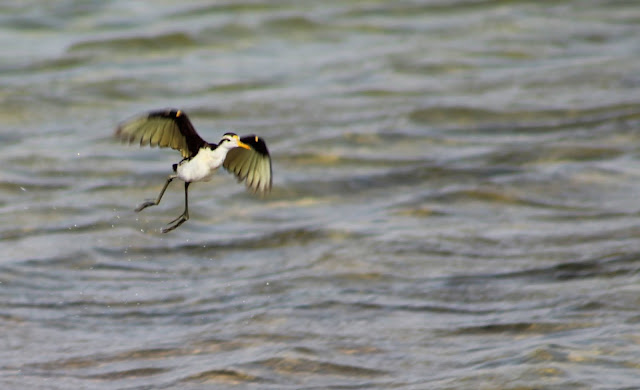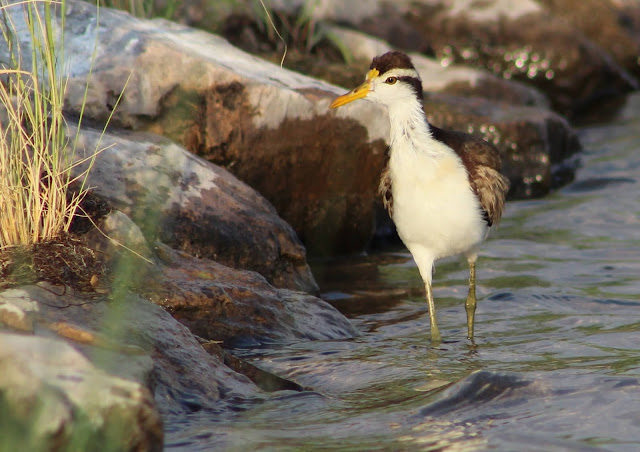When you chase birds and are always on alert of when a mega-rarity might show up, you know that you can start off a day as being thought of as a typical day. Halfway through the day a report might come in, and you'll find yourself looking for a bird at a location that didn't cross your mind of being at at the beginning of the day.
This will be the first "mini-series" I have done on TDBE. It will include two posts, because it needs two posts. What happened was that I've had one of the craziest weeks in birding that I have had in my life. Unexpected birds showed up, and the experiences were epic. A variety of sequences took place. The week started on Wednesday afternoon, September 9th, at about 3:15 P.M at Canoa Ranch Conservation Park, and the week ended on Wednesday afternoon, September 16th, at about 3:00 P.M. when I dropped Caleb Strand off at his house after an epic birding adventure that we had. This week had almost too many great birds. Read along to find out what they were!
When I arrived at Canoa Ranch Conservation Park on September 9th, I was chasing an incredible bird. I think I heard up to ten different ways it's came can be pronounced. Who knows how many different times I've pronounced it myself. To get to the point, the bird is called a Northern Jacana. And one was being seen at Canoa Ranch.
On September 7th, someone reported a Northern Jacana to the birding community, where they discovered it at Arivaca Lake in Pima County. It was shocking to see the report come in. The last Northern Jacana in Arizona was in 2008, and was at a lake in Casa Grande, where it spent months. I joined the birding community in 2009, and ever since I have been a serious Arizona birder, it was the first Jacana that has been reported. The birder reported seeing it briefly, and it wasn't seen again. On September 8th, birders searched and searched for the bird at Arivaca Lake. Some hiked, and some kayaked. It wasn't to be seen there. But a or the bird, was found at a golf course pond in Green Valley. This location was on private property, and getting access was a serious challenge. Only a few lucky birders were able to see it that evening when it was found (or re-found). Arivaca Lake isn't far from the Green Valley location. On September 9th, the bird couldn't be found at the golf course pond, but it was found at the lake at Canoa Ranch. The Canoa Ranch lake has attracted many birds, including an Arctic Tern earlier this year. Many birders piled in to see the Jacana when it was relocated. I went through work knowing I would chase it. It was all I thought about all day long.
When 1 P.M. hit, I was traveling down the 1-10 and on my first ever Northern Jacana chase. I really really really wanted to see this bird, and I worried it would leave before I got there. I knew that Canoa Ranch closed at 4, and I was scheduled to get to the Ranch not long after 3. It would give me about 45 minutes with the bird, which isn't much time at all for a neat bird. I got to Canoa Ranch and quickly got to where the birders were seeing the bird. And the bird was still right there! It flew across the lake, which was small, and I walked right over to it and got to a spot where I could see it closely without spooking it.
What stands out to me about the Northern Jacana (this one is a juvenile), are the huge toes on it's feet. It is truly a strange-looking bird. More and more birders came, and the Jacana flew right back to another edge of the lake.
Northern Jacana is a attention-getting rarity in the ABA area, and is a Code 4. This species is a Mexican vagrant that has shown up most often in Texas, as well as five times in Arizona prior to this bird. Once again, the features of this bird were really fun to see live.
What exactly is a Northern Jacana? When I look at it, it strikes me as a mix between a gallinule and a shorebird. Despite it's oddness, it is in fact placed in the shorebird family.
I spent a good forty minutes with the bird before I knew the gates to Canoa Ranch would close, and I enjoyed watching it as the time went by very fast. The Northern Jacana became my 622nd life bird. This species once bred in south Texas, where it has been discovered most often. The usual range of the species falls in Mexico and Central America. When water sources dry up in their usual range, it forces them to go elsewhere, such as Arizona and Texas.
Northern Jacanas breed in freshwater marshes that have lots of floating vegetation. They can be found in other wet areas, such as lake edges and flooded fields. Their super long toes allow them to walk on the floating vegetation with ease as they search for food source. They walk slowly along in their foraging, such as in this case, as the juvenile at Canoa Ranch was walking along the lake edge in search of food. When it would fly, it would stay low over the water, and would hold it's wings up after landing. If Canoa lake had floating vegetation, it would've been awesome to see this bird walk on it! And even though it's a shorebird, the Northern Jacana doesn't associate with other shorebirds very often. It actually hangs out in the company of gallinules quite often.
It was also cool to hang out with these guys, and to have a Phoenician Kingbird reunion and induction.
After 4 P.M., I thought my time with the epic Jacana was likely done. I went down the street to Amado Wastewater Treatment Plant. There were four species of terns present: Least, Black, Common, and Forster's Terns, all of which were new for my Pima County list. Here is a photograph of the Least Tern.
When I was at Amado, I found out that birders were able to park outside of Canoa Ranch and walk to the lake through the gate. I was stoked to find this out, and it resulted in me going right back to spend about an hour with the Northern Jacana, and it was time I thought I wasn't going to have. What a fun bird to see for the first time!
Up next is the rest of this epic "week".....

























No comments:
Post a Comment